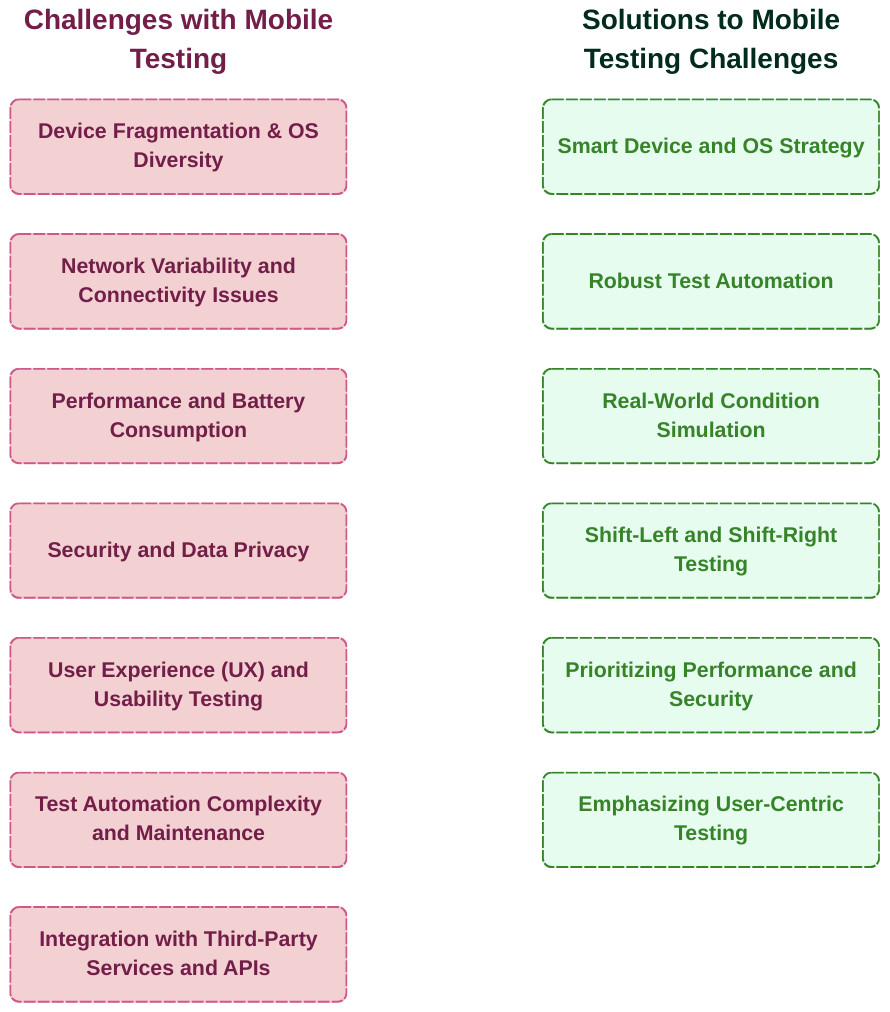Top Mobile Testing Challenges
|
|
Think about your day. How many times have you picked up your phone or tablet? We tap, swipe, and scroll, expecting the computer to keep pace—zero lag, no glitching. And when an app does flounder, enough such that we’re forced to delete it — and maybe even dust off the one-star review button — it’s not a small irritation.
But here’s the little seen reality: achieving this perfect mobile experience is crazy complex. But behind that polished animation or well-executed transaction on the app lies a maze of headache for the teams that build and – crucially – test these applications.
Why does this all matter? Because in the age of digital, when users expect so much, the pressure is on. A buggy app is not just a small inconvenience, it can damage your brand and frustrate users, resulting in lost revenue. High-quality is not just a nice habit. It is life or death, and life or death of a business.
| Key Takeaways: |
|---|
|

The Top Mobile Testing Challenges
Let’s break down the major hurdles that QA teams face every single day.
Device Fragmentation & OS Diversity
Imagine trying to design a single shirt that perfectly fits every single person on the planet, regardless of their size, shape, or preference. That’s essentially what mobile app developers and testers are up against with device fragmentation. There’s an astonishing number of mobile devices out there – from tiny smartphones to massive tablets, foldable screens, and everything in between. Each comes with its own screen size, resolution, processing power, and subtle hardware differences.
On top of that, you have the operating systems. It’s not just Android versus iOS; it’s also various versions of Android (Lollipop, Nougat, Pie, Android 14, etc.) and different iOS iterations. Each new OS update can introduce changes that break existing app functionalities or alter the user interface. Trying to ensure your app looks, feels, and performs consistently across this dizzying array of combinations is a monumental task, often leading to endless testing cycles and the fear of missing a critical bug on a less common device.
Network Variability and Connectivity Issues
Mobile apps don’t live in a perfect, stable internet bubble. Your users could be on blazing-fast 5G, struggling with a patchy 2G connection in a rural area, or even completely offline in an airplane or subway. They might transition from Wi-Fi to cellular data, or lose signal entirely while passing through a tunnel.
Testing an app’s behavior under these wildly varying network conditions is crucial. Does it degrade gracefully on a slow connection? Does it handle sudden disconnections without crashing? Can it store data offline and sync it seamlessly once reconnected? Neglecting this aspect can lead to unresponsive apps, failed transactions, and data loss, all of which quickly erode user trust.
Performance and Battery Consumption
Nobody likes a sluggish app. If your app takes too long to load, freezes frequently, or struggles with resource-intensive tasks, users will abandon it faster than you can say “bug.” But it’s not just about speed. Mobile users are also incredibly sensitive to battery drain. An app that chews through their phone’s battery in a few hours is a definite no-go.
Performance testing for mobile apps involves far more than just checking response times. It means meticulously analyzing memory usage, CPU consumption, app launch times, and how efficiently the app handles graphics and animations. It’s about ensuring your app delivers a consistently smooth and energy-efficient experience, even during heavy use.
Security and Data Privacy
In an era where data breaches are, unfortunately, commonplace, the security of mobile apps is critical. Apps frequently manage extremely sensitive user data, from personal information to payment information and location. Securing this data from unauthorized access, guaranteeing a secure authentication process, and above all, being compliant (like with GDPR and CCPA) is not up for debate.
Mobile security testing also includes searching for vulnerabilities such as weak encryption, insecure data storage, improper session handling, etc., which attackers may take advantage of. From massive brand damage and enormous fines to your audience’s trust for your apps completely waning, all it takes is one security vulnerability to cause a world of hurt.
User Experience (UX) and Usability Testing
An app might technically “work,” meaning all its buttons do what they’re supposed to. But is it easy to use? Is it intuitive? Does it feel good in the user’s hand? This is where UX and usability testing come in. It’s about ensuring the app’s flow is logical, gestures are recognized correctly (like pinch-to-zoom or swiping), and the interface is clear and visually appealing.
This also includes testing how the app behaves when interrupted – what happens if a phone call comes in, or a text message notification pops up? Does the app resume seamlessly? Ignoring usability can lead to a perfectly functional but ultimately frustrating app that users quickly uninstall because it’s just too much effort to navigate. We’re also talking about accessibility – ensuring the app can be used by people with disabilities.
Test Automation Complexity and Maintenance
Mobile test automation is no walk in the park. Mobile UIs are mutable, leading to brittle test scripts that become obsolete. This causes what’s known as a “maintenance burden,” making QA teams spend more time repairing broken tests than creating new ones.
Setting up robust automation frameworks for mobile often requires specialized coding skills and a deep understanding of mobile ecosystems. This complexity can make automation slower to implement than expected and difficult to maintain over time, often turning what should be an accelerator into a costly bottleneck.
Integration with Third-Party Services and APIs
Very few mobile apps exist in isolation. Most integrate with a variety of external services: think payment gateways (PayPal, Stripe), social media logins (Google, Facebook), mapping services (Google Maps), analytics tools, and countless other APIs. While these integrations enrich the app’s functionality, they also introduce new points of failure.
Thoroughly testing these third-party integrations is critical. Did the payment process complete successfully? Does the social media login work flawlessly? Is data being passed correctly and securely between your app and the external service? If any of these connections break, core functionalities of your app can grind to a halt, directly impacting the user’s ability to complete their tasks.
Overcoming Mobile App Testing Challenges
The good news is that while mobile testing presents unique complexities, there are powerful approaches and innovative tools available today to help your team navigate them effectively. It’s about being strategic, leveraging the right technology, and fostering a collaborative mindset.
Smart Device and OS Strategy
With the plethora of devices and OS versions currently available, it would just be silly to try to test on all of them. The trick is to do this smartly. Take a look at the user base, look at the current trends in the markets, and see which devices and OS versions are the most common today. Focus testing on these key combinations, which the vast majority of users will use.
This can then be supplemented with a mix of real devices, cloud-based device labs (which offer access to a wide selection of physical devices remotely), and emulators/simulators for testing in the early stage. Not that you are trying to support every single device ever made, it’s about being smart about covering the devices your customers actually use.
Robust Test Automation
We touched on the complexities of test automation earlier, but don’t let that deter you. Automation is absolutely essential for keeping pace with mobile development cycles. The key is to build robust and maintainable automated tests that don’t constantly break with minor UI changes. This frees up your human testers to focus on more complex, exploratory, and user-centric testing.
Real-World Condition Simulation
Your app needs to perform flawlessly, not just in ideal conditions, but in the messy, unpredictable real world. This means actively simulating varied network conditions (from strong Wi-Fi to patchy 2G), mimicking interruptions like incoming calls or text messages, and even testing how your app behaves when the device’s battery is low.
Shift-Left and Shift-Right Testing
“Shift-left” means moving testing activities earlier in the development lifecycle – catching bugs when they’re cheaper and easier to fix. This involves developers writing unit and integration tests, and QA getting involved in the design phase. “Shift-right” involves continuously monitoring the app’s performance and user experience once it’s released to gather real-world feedback and identify issues in production. Using both these methods in tandem is a great way to ensure continuous testing.
Prioritizing Performance and Security
Don’t treat performance and security testing as afterthoughts. Utilize specialized approaches to performance testing to measure the speed, responsiveness, and power consumption of your app, and test for security gaps with regular auditing and penetration testing.
Emphasizing User-Centric Testing
Ultimately, your mobile app is for your users. Beyond functional correctness, it needs to be enjoyable and intuitive. This means incorporating dedicated usability testing sessions, gathering direct user feedback, and conducting accessibility testing to ensure your app is usable by everyone, regardless of their abilities.
Using Smart Test Automation Tools
With a myriad of concerns when tackling mobile testing, having a test automation tool that is versatile enough to cover all your testing needs is a necessity. Most traditional tools struggle with the dynamic nature of mobile applications, leading to you having to rely on multiple third-party services for a framework. This hassle ends when you opt for intelligent AI-driven tools like testRigor.
At its core, testRigor is engineered to cut through the complexity of mobile testing, letting your team focus on delivering a truly great user experience rather than wrestling with tools. Here’s how it becomes an indispensable part of your mobile quality strategy:
- Codeless Automation: It allows anyone on your team, regardless of their coding background, to create robust automated tests using plain English commands. This means your business analysts, product managers, and manual QA testers can all contribute directly to automation, accelerating test creation by up to 15x.
- AI-Powered Stability: One of the most tedious parts of mobile automation is having to put up with broken tests for tiny changes made to the UI. testRigor leverages advanced AI to comprehend your app’s UI as a human would. When buttons shift a little or text labels change, tests in testRigor dynamically refocus themselves, so you don’t have to constantly tweak your tests, meaning super robust, self-repairing tests! This significantly cuts down your test maintenance load, saving you hours and hours for your team.
- True Cross-Platform and Cross-Device Support: You noted the challenge posed by “device fragmentation. With testRigor, you describe your test once in simple English and then run it across mobile devices, operating systems, and even browsers with little trouble. It’s all about reliable functionality and a pretty appearance for your users, no matter what device they have, with the single side-effect of not having to re-write tests for every other platform.
- Unprecedented Speed and Scalability: It’s a race, a real race in the pale and pasty world of mobile app publishing. testRigor Allows ultra-fast testing in order to know how good your app is. This fast feedback loop is critical to developing “shift-left” habits and making sure your CI/CD pipeline hums, so you can scale testing in line with your development speed.
- Ease of Integration: testRigor is built to be easily integrated into your current CI/CD pipelines and DevOps processes. Whether you are using Jenkins, GitLab, Jira, Slack, or another tool, testRigor easily integrates to incorporate testing as a natural, automated part of your development process and to analyze your tests to continuously provide feedback to your team.
- Simple Tests that Anyone can Read: Tests are written in normal human-readable English, no mysteries here. This visibility promotes closer teamwork between development, QA, product and yes even the business. Everyone is testing the same thing, and they know exactly what is being tested, and why, and so requirements are clearer, there are fewer misunderstandings, and everyone is committed to quality.
Conclusion
So, there you have it. We’ve been deep into the weeds of mobile testing – the difficulties associated with device fragmentation, varying network conditions, the ongoing fight with performance and security, and the ongoing labor of managing evergreen automation. These aren’t small inconveniences; they’re large obstacles that can be the difference between the success or failure of a mobile app in the hands of real users.
But the main thing is not to be daunted by the problems, but to know that they can be solved. By taking smart approaches – such as focusing on your device coverage, giving and welcoming continuous feedback, and making user experience a top priority – with the support of the right tools, potential becomes reality for your mobile testing.
Additional Resources
- All about Mobile Testing
- Mobile Testing: Where Should You Start?
- Mobile First Design Testing – How to Guide
- How to do mobile testing using testRigor?
- Choosing the Best Mobile Testing Option: Real Devices vs. Emulators
- 5G and Mobile Test Automation: What is the Impact?
- Top 10 Mobile Testing Tools
- Why Using a Device Farm is a Good Idea for Mobile Testing
| Achieve More Than 90% Test Automation | |
| Step by Step Walkthroughs and Help | |
| 14 Day Free Trial, Cancel Anytime |












